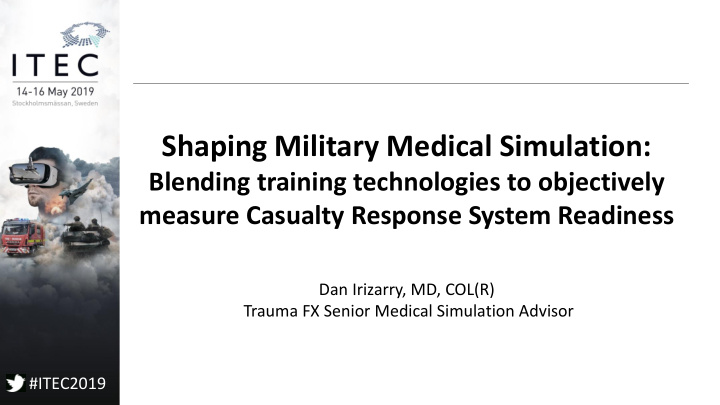



Shaping Military Medical Simulation: Blending training technologies to objectively measure Casualty Response System Readiness Dan Irizarry, MD, COL(R) Trauma FX Senior Medical Simulation Advisor #ITEC2019
Disclosures Dr. Dan Irizarry, MD, COL(R): KGS TFX Dr. Dawn Riddle (PhD): None Dr. Jon-David Hague (PhD): Cerego Mr. Alex Hill, BA, MBA: KGS TFX #ITEC2019
Technologies Cerego TC3 All Combatant TFX APL-HEMO/ PB Cognitive Trainer (TC3 ACCT) #ITEC2019
Study Design #ITEC2019
Training Arms Hands On Practice Cerego Didactic Delivery Traditional Didactic Delivery Hands On Testing #ITEC2019
Confidence to Perform TC3 Confidence to Perform TC3 was not diminished by the distributed learning platform #ITEC2019
Student Perception of TC3 ACCT #ITEC2019
Objective Bleeding Measurement (mL) Platform capable of objectively measuring performance can be used to assess teaching #ITEC2019 method effectiveness
Results 5.3 Hours TC3 ACCT vice 12 hours lecture. • Students using the App demonstrated a significant increase in TCCC knowledge from pre-test to post test (t=11.14; p<.00001). In separate analysis, even students with prior CLS training demonstrated significant knowledge gain using the mobile app (t=8.75; p<.05). Students learning through face to face didactic instruction also demonstrated a significant increase in TCCC Knowledge from pre-test to post-test (t=4.9; p<.05) Similar gains in knowledge were seen for both App and face to face cohorts as measured by the change in knowledge scores from pre to post test (X gainApp =5.31; X gainBFR-D =5.33; F=.0005; p<.05). • Student knowledge gains after an average 5.37 hrs using the app (plus 1-hour scenario review) was comparable to knowledge gains after 12 hours face to face instruction. • TC3 ACCT methodology = to current methods of training. Hands on training matters • In terms of volume blood loss, differences between students in the mobile app condition and the traditional BFR group were negligible (X app =584; X BFR = 583), and substantially less than the control condition (X BFR-didactic =635). #ITEC2019
Casualty Response and Combat Power FM 3-0 Operations (2017) FM 3-0 Operations (2008) • Casualty Response effects many of the elements of combat power. • Casualty Response efficiency Increases combat power. • Objective measurement of readiness increases confidence in combat #ITEC2019 power
Lessons Learned • COTS technologies are available today to meet immediate and future training needs. Programmatic funding is the issue. • Artificial intelligence enhanced distributed learning is a viable option for Soldier training and offers the benefits of standardized presentation, individualized presentation and measurable knowledge mastery. • Realistic, durable high fidelity trauma manikins that capture objective performance data were foundational to supporting the Commanders assessment of casualty response readiness and training effectiveness. Used at point of need, they sustain medic skills while creating first responder skills. • Advance development is required to create an integrated, connected training system capable of measuring the trauma system. • The Army learning model is shifting to a synthetic training environment centric system. Medical simulation must match this paradigm shift by creating capabilities that connect to the the synthetic training environment with the ability to capture and port data from live, virtual and augmented simulation devices into future learning management, training and simulation systems. • “25 Bloodless Battles” before combat requires sustained investment in medical simulation which starts with user driven requirements generation. • If throughput is the issue, distributive Point of Need training is the answer for the future Army training system. #ITEC2019
Final thoughts We must make an educational shift from the archaic lecture based training to decentralized, scalable platforms that ensure knowledge mastery and increase learning efficiency. #ITEC2019
Final thoughts We must make investments in simulation training technologies that objectively capture an measure performance. #ITEC2019
References • R.S. Kotwal, H.R. Montgomery, B.M. Kotwal, H.R. Champion, F.K. Butler Jr, R.L. Mabry, J.S. Cain, L.H. Blackbourne, K.K. Mechler, J.B. Holcomb, Arch Surg. 146(12):1350-8 (2011) • CENTCOM Report Saving Lives on the Battlefield (Part II)- One Year Later: A Joint Theater Trauma System & Joint Trauma System Review of Pre-Hospital Trauma Care in Combined Joint Operating Area – Afghanistan (CJOA-A)14 May 2014 http://www.naemt.org/docs/default-source/education- documents/tccc/10-9-15-updates/centcom-140530-saving-lives-on-the- battlefield-ii-final.pdf • TRADOC Pamphlet 825-8-2 The U.S. Army Learning Concept for Training and Education 2020-2040 APR 2017 • DoD Instruction 1322.24 Medical Readiness Training (MRT) March 16, 2018 http://www.esd.whs.mil/DD/ • J. Mattis, CENTCOM Commander Memorandum to Chiefs of Services “Killed in Action (KIA) Reduction Initiative.” 18 JAN 2013 • FM 3-0 Operations. Headquarters, Department of the Army. OCT 2017 #ITEC2019
Acknowledgements PEO STRI JPM MMS MG Mark O’Neil, CG, USARAK The Soldiers of 1-5 IN BN #ITEC2019
Recommend
More recommend